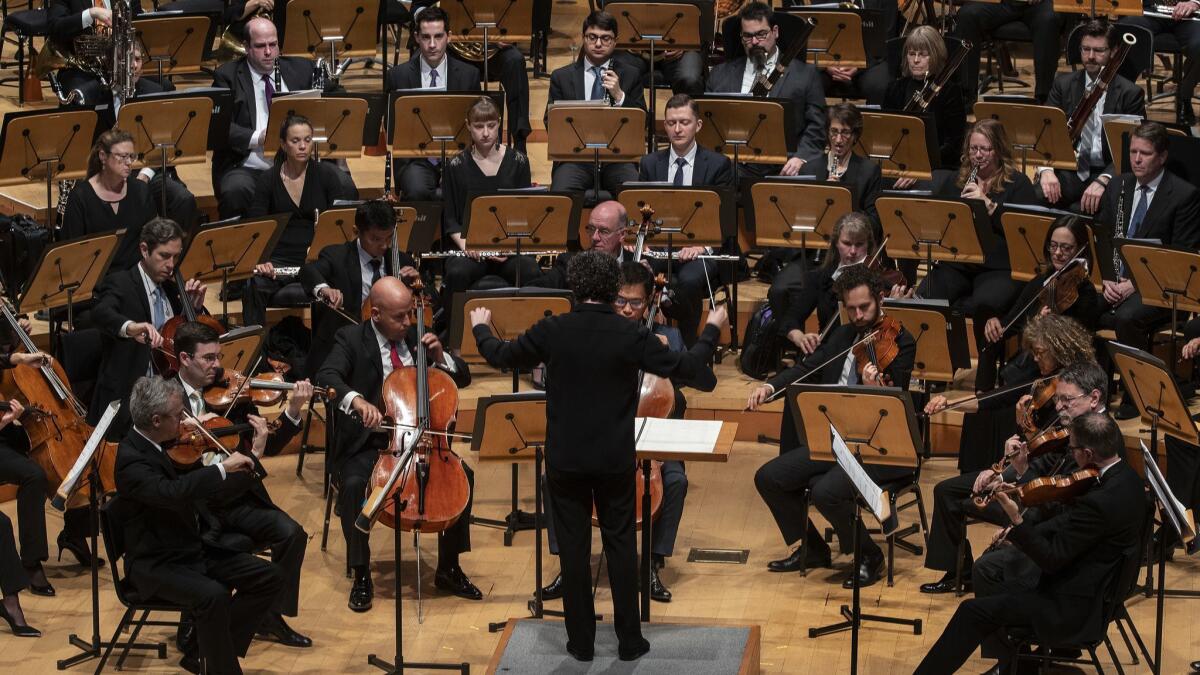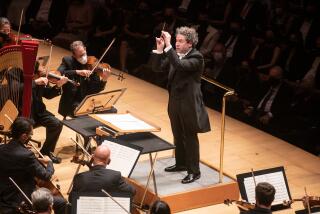Review: Salonen’s ‘Pollux’ supplies some grunge for L.A. Phil tour

“There is something intriguing,” Esa-Pekka Salonen writes in the notes for his solemnly captivating new orchestral piece, “Pollux,” “about [a] famed beauty having a penchant for large water birds.”
There is also something intriguing about this translucently liquid 12-minute score that Salonen wrote for the Los Angeles Philharmonic. He named it for one of the twin sons of Leda, queen of Sparta, who was seduced by Zeus in the form of a swan, and it’s based on a grunge rhythm Salonen heard in the background at a restaurant in Paris.
With its glistening, pure sonorities and murky underpinning, “Pollux” was given its first performances by Gustavo Dudamel over the weekend at Walt Disney Concert Hall (I heard the second of three performances, Saturday afternoon). The big birds, and the torrential splash, came a little later, in Varèse’s “Amériques,” offered at its most deafening, and in Shostakovich’s Fifth Symphony, at its most unsettling. That completed one of the programs the orchestra will take to the East Coast this month and to London and Paris the first week of May.
At home, every new Salonen work for the L.A. Phil is an occasion. But for the first time, the composer did not himself conduct — something he likes, if for no other reason than it allows him to write up to the last minute, rather than allow time for another conductor to learn the score. Currently conducting the Philharmonia Orchestra in Britain, Salonen will catch “Pollux” at Lincoln Center.
Even figuring out exactly what “Pollux” is can be a little confusing. The commission had been for a short work, but Salonen said the material led to a much bigger piece, in two parts, over 20 minutes, which he dubbed “Castor” and “Pollux” after the mythological Leda’s very un-identical twins. The former was mortal, Leda already impregnated when Zeus got to her, while Pollux was divine.
So, the “Castor” movement, which will apparently be lively, is on hold. “Pollux,” meanwhile, is mysterious. Salonen writes that he got inspiration from Rilke’s fantastic likening of Orpheus’ song to a tree growing out of an ear.
Much of “Pollux” is a wash of sound. Impressionistic string arpeggios, along with other rapid figures, moody thick chords and glissandi pervade much of the piece. Fast, quiet figures in the winds offer shimmer. The deep-sea contrabass clarinet and contrabassoon that Salonen love contribute a strange bottom to the orchestral sound. Percussion shimmers too, in its metallic way. Solo melodies haunt the winds and brass, coming out of nowhere.
The grunge rhythm lurks rather than dominates, rarely catching attention — more like moss than muck in the spring water. Repetition will be required to appreciate all the little things too subtle to catch the first time around. For now, though, the main impression on first hearing is that “Pollux” needs its brother.
No orchestra can match the L.A. Phil in having a feeling for Salonen’s music, and though Salonen may seek greater transparency when he gets around to conducting “Pollux,” Dudamel brought wonderfully subdued qualities of light and darkness to the instrumental textures.
After that, all hell broke loose in “Amériques.” Written shortly after Varèse immigrated to New York in 1918, the score for huge orchestra with hoards of percussion and brass sounds like a brash Parisian modernist in Manhattan. An aggressive alto flute solo that opens the work won’t leave the listener alone, as though every time Varèse turns a corner, there is this inescapable thing.
A lot of other things are around other corners. A siren wails. A lion roars, thanks to a then-new percussion instrument that imitates the threatening wild creatures. Finally, the whole city seems to crescendo in shell-shocking sounds that had many players in the orchestra reaching for their earplugs while producing a bravura performance. If the East Coast thinks we’re flashy, Dudamel will show ’em flashy.
The East Coast currently owns Shostakovich’s Fifth Symphony. The Boston Symphony won a 2016 Grammy for orchestral performance for its sumptuous recording of the symphony under Andris Nelsons. The Pittsburgh Symphony won a 2017 Grammy for orchestral performance for its capable recording of the symphony under Manfred Honeck. A year ago, New York Philharmonic music director-designate Jaap Van Zweden led the L.A. Phil in Shostakovich’s Fifth in Disney Hall with aggressive directness.
Dudamel brings urgency. The 1937 symphony represents Shostakovich’s fraught relationship with Stalin. We will never know exactly what the wild shifts among fervent expression, deep, depressive, trembling angst, playfulness, bombast and outright pomposity mean. Such mood swings, prompted by an unpredictable leader, are what gives the symphony its lasting relevance.
The great Shostakovich conductors — notably Yevgeny Mravinsky, the great Russian conductor who premiered the Fifth; Leonard Bernstein, who used the Fifth for Cold War diplomacy; and Valery Gergiev — know better than to look for answers. On the other hand, Nelsons, Honeck and Van Zweden all feel to me like therapists there to help Shostakovich cope.
Dudamel, who has his own fraught relationship with tyranny in his native Venezuela, offered a panoramic view of Shostakovich’s symphony, so much so that it leaves a bitter taste in your mouth when it’s over, just as it should. He doesn’t pretend the ending isn’t thrilling. He doesn’t pretend that Shostakovich’s greatness may not be so much in defiance but in the vagaries of survival, psychic as well as physical.
In a peculiar choice for an encore, since tour programs always need encores, Dudamel ended with a surprise — Wagner’s “Liebestod,” from “Tristan und Isolde.” In one sense, this was a full circle back to the sensual beauty of Salonen (maybe even a nod to Salonen’s remarkable “Tristan” Project with the orchestra). But in a more important sense, the “love death” music became the revelation of a striving for something higher than survival. The bitterness became manna.
More to Read
The biggest entertainment stories
Get our big stories about Hollywood, film, television, music, arts, culture and more right in your inbox as soon as they publish.
You may occasionally receive promotional content from the Los Angeles Times.







